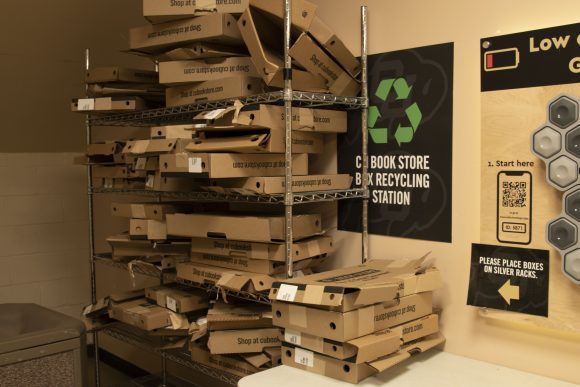
Textbook boxes piled on a rack located at the exit of the University of Colorado Boulder Book Store on Oct. 5, 2022. (Celia Frazier/CU Independent)
Outside of the University of Colorado Boulder Bookstore this semester, cardboard boxes from textbooks could be seen piled high on tables. These boxes accumulated rapidly during the back-to-school rush, causing issues for campus recycling facilities.
“What people are seeing with the increased number of boxes stacked up is [mostly due] to staffing [issues],” said Matthew Avena, the academic resource department manager at the CU Bookstore. “It’s tough to recruit and keep people, especially temporary employees, which we use a lot of during the back-to-school [period].”
Near the bookstore exits, signs encourage students to leave empty textbook boxes on racks or tables to be reused for future orders. However, during the beginning of the semester, students often take the boxes out of the bookstore and dispose of them elsewhere.
According to Barry Sparks, the facilities management zero waste outreach program manager, this can lead to recycling issues elsewhere on campus.
“For our grounds people, it’s a problem when the students take the boxes with them,” Sparks said. “They open them somewhere while they’re walking along and then put them on top of one of the outdoor regular trash and recycling, which basically blocks access to it.”
For next semester, the CU Bookstore and Facilities Management are working together to improve the system to ensure fewer textbook boxes leave the bookstore, which they hope will reduce waste and the negative impact on campus recycling facilities.
According to Avena, who has worked at the bookstore for 13 years, the use of boxes to package textbooks began 10 years ago when the bookstore implemented its self-service, in-store pickup system. The bookstore orders roughly 20,000 boxes every one to two years, which fulfills about 80,000 orders. On average, the bookstore uses each box about four times, although some may be badly torn in the opening process and cannot be reused.
“High-value items are what is infinitely recyclable, and cardboard is one of those items,” Sparks said. “We’re trying to save as much cardboard as we can.”
When the COVID-19 pandemic hit, the bookstore moved everything online. In-store pickup and shipping became the only two options for receiving textbooks from the bookstore.
Post-pandemic, the bookstore decided to keep the online ordering system and not reopen the floor where students could find their own books. One main reason for this was the decrease in returns of incorrectly purchased books seen after switching to the online ordering system.
“That’s a sign that students are getting what they need, which is great for us and great for students,” Avena said.
In addition to reducing this issue, the new system also allows students to receive more information about digital textbooks and rental options and to find a list of required books for classes.
After introducing the new system at the start of the pandemic, Avena says the bookstore has observed a slight increase in orders and box usage. However, the number of orders has stayed steady over the past three years since that initial increase.
For the spring semester, the bookstore is taking steps to minimize the textbook box pileup issues by finding ways to safely provide a tool to open the boxes and considering sealing alternatives. The bookstore also hopes for staffing issues to work themselves out next semester.
“We concentrate more of our labor on trying to get the book orders out,” Avena said. “Some things, like boxes, can stack up a little more than we’d like.”
Contact CU Independent Breaking News Editor Celia Frazier at celia.frazier@colorado.edu.
